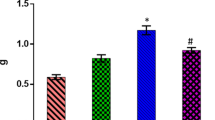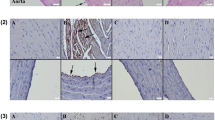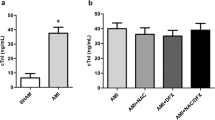Abstract
The present study was undertaken to evaluate the cardioprotection potential and underlying molecular mechanism afforded by a selenium (Se) polysaccharide (Se-AVP) from Aloe vera in the ischemia-reperfusion (I/R) model of rats in vivo. Myocardial I/R injury was induced by occluding the left anterior descending coronary artery (LAD) for 30 min followed by 2-h continuous reperfusion. Pretreatment with Se-AVP (100, 200, and 400 mg/kg) attenuated myocardial damage, as evidenced by reduction of the infarct sizes, increase in serum and myocardial endogenous antioxidants (superoxide dismutase (SOD), glutathione peroxidase (GSH), and catalase (CAT)), and decrease in the malondialdehyde (MDA) level in the rats suffering I/R injury. This cardioprotective activity afforded by Se-AVP is further supported by the decreased levels of cardiac marker enzymes creatine kinase (CK) and lactate dehydrogenase (LDH), as well as the rise of myocardial Na+-K+-ATPase and Ca2+-Mg2+-ATPase activities in I/R rats. Additionally, cardiomyocytic apoptosis was measured by terminal-deoxynucleotidyl transferase-mediated nick end labeling (TUNEL) staining and the result showed that the percent of TUNEL-positive cells in myocardium of Se-AVP-treated groups was lower than I/R rats. In conclusion, we clearly demonstrated that Se-AVP had a protective effect against myocardial I/R injury in rats by augmenting endogenous antioxidants and protecting rat hearts from oxidative stress-induced myocardial apoptosis.





Similar content being viewed by others

References
Hansen PR (1995) Myocardial reperfusion injury: experimental evidence and clinical relevance. Eur Heart J 16:734–740
Visioli F, Keaney JF Jr, Halliwell B (2000) Antioxidant and cardiovascular disease; panacea or tonics for tired. Cardiovasc Res 47:409
Zweier JL (1988) Measurement of superoxide-derived free radicals in the reperfused heart. J Biol Chem 263:1353–1357
Buttke TM, Sandstrom PA (1994) Oxidative stress as a mediator of apoptosis. Immunol Today 15:7–10
Chen EP, Bittner HB, Davis RD, Folz RJ, VanTrigt P (1996) Extracellular superoxide dismutase transgene overexpression preserves postischemic myocardial function in isolated murine hearts. Circulation 94:II412–II417
Hockenbery DM, Oltvai ZN, Yin XM, Milliman CL, Korsmeyer SJ (1993) Bcl-2 functions in an antioxidant pathway to prevent apoptosis. Cell 75:241–251
Rodríguez ER, Darias JM, Díaz CR (2010) Aloe vera as a functional ingredient in foods. Crit Rev Food Sci Nutr 50:305–326
Maze G, Terpolilli RN, Lee M (1997) Aloe vera extract prevents aspirin-induced acute gastric mucosal injury in rats. Med Sci Res 25:765–766
Heggers JP, Pelley RP, Robson MC (1993) Beneficial effects of Aloe in wound healing. Phytother Res 7:S48–S52
Vázquez B, Avila G, Segura D, Escalante B (1996) Antiinflammatory activity of extracts from Aloe vera gel. J Ethnopharmacol 55:69–75
Mazzulla S, Sesti S, Schella A, Perrotta I, Anile A, Drogo S (2012) Protective effect of Aloe vera (Aloe barbadensis Miller) on erythrocytes anion transporter and oxidative change. Food Nutr Sci 3:1697–1702
Volger BK, Ernest E (1999) Aloe vera: a systemic review of its clinical effectiveness. Br J Gen Pract 49:823–828
Hamman JH (2008) Composition and applications Aloe vera leaf gel. Molecules 13:1599–1616
Kaithwas G, Singh P, Bhatia D (2014) Evaluation of in vitro and in vivo antioxidant potential of polysaccharides from Aloe vera (Aloe barbadensis Miller) gel. Drug Chem Toxicol 37:135–143
Liu CH, Wang CH, Xu ZL, Wang Y (2007) Isolation, chemical characterization and antioxidant activities of two polysaccharides from the gel and the skin of Aloe barbadensis Miller irrigated with sea water. Process Biochem 42:961–970
Staub AM (1965) Removal of protein-Sevag method. Methods Carbohydr Chem 5:5–6
Dubois M, Gilles KA, Hamilton JK, Rebers PA, Smith F (1956) Colorimetric method for determination of sugars and related substances. Anal Chem 28:350–356
Bradford MM (1976) A rapid and sensitive method for the quantitation of microgram quantities of protein utilizing the principle of protein binding. Anal Biochem 72:248–254
Filisetti-Cozzi TMCC, Carpita NC (1991) Measurement of uronic acids without interference from neutral sugars. Anal Biochem 197:157–162
Gao Z, Chen J, Qiu S, Li Y, Wang D, Liu C, Li X, Hou R, Yue C, Liu J, Li H, Hu Y (2016) Optimization of selenylation modification for garlic polysaccharide based on immune-enhancing activity. Carbohydr Polym 136:560–569
Sun Y, Wang S, Li T, Li X, Jiao L, Zhang L (2008) Purification, structure and immunobiological activity of a new water-soluble polysaccharide from the mycelium of Polyporus albicans (Imaz.) Teng. Bioresour Technol 99:900–904
Jones TM, Albersheim P (1972) A gas chromatographic method for the determination of aldose and uronic acid constituents of plant cell wall polysaccharides. Plant Physiol 49:926–936
Oades JM (1967) Gas–liquid chromatography of alditol acetates and its application to the analysis of sugars in complex hydrolysates. J Chromatogr 28:246–252
Song M, Huang L, Zhao G, Song Y (2013) Beneficial effects of a polysaccharide from Salvia miltiorrhiza on myocardial ischemia-reperfusion injury in rats. Carbohydr Polym 98:1631–1636
Kloner RA, Rude RE, Carlson N, Maroko PR, DeBoer LW, Braunwald E (1980) Ultrastructural evidence of microvascular damage and myocardial cell injury after coronary artery occlusion: which comes first. Circulation 62:945–952
Adegunloye BJ, Omoniyi JO, Owolabi OA, Ajagbonna OP, Sofola OA, Coker HAB (1996) Mechanisms of the blood pressure lowering effect of the calyx extract of Hibiscus sabdariffa in rats. Afr J Med Sci 25:235–238
Onyenekwe PC, Ajani EO, Amechi DA, Garnamel KS (1999) Antihypertensive effect of Rosselle (Hibiscus sabdariffa) calyx infusion in spontaneously hypertensive rats and a comparison of its toxicity with that in Wistar rats. Cell Biochem Funct 17:199–205
Zhao W, Li JJ, Yue SQ, Zhang LY, Dou KF (2012) Antioxidant activity and hepatoprotective effect of a polysaccharide from Bei Chaihu (Bupleurum chinense DC). Carbohydr Polym 89:448–452
Yan B, Jing L, Wang J (2015) A polysaccharide (PNPA) from Pleurotus nebrodensis offers cardiac protection against ischemia–reperfusion injury in rats. Carbohydr Polym 133:1–7
Parlakpinar H, Ozer MK, Acet A (2005) Effect of aminoguanidine on ischemia-reperfusion induced myocardial injury in rats. Mol Cell Biochem 277:137–142
Basaga HS (1990) Biochemical aspects of free radicals. Biochem Cell Biol 68:989–998
Bansal P, Gupta SK, Ojha SK, Nandave M, Mittal R, Kumari S, Arya DS (2006) Cardioprotective effect of lycopene in the experimental model of myocardial ischemia-reperfusion injury. Mol Cell Biochem 289:1–9
Zhang J, Wang H, Zheng Q (2013) Cardioprotective effect of Aralia elata polysaccharide on myocardial ischemic reperfusion (IR) injury in rats. Int J Biol Macromol 59:328–332
Ke YS, Wang DG, Wang HG, Yang SY (2004) Endoxin antagonist lessens myocardial ischemia reperfusion injury. Cardiovasc Drugs Ther 18:289–293
Bassenge E1, Sommer O, Schwemmer M, Bünger R (2000) Antioxidant pyruvate inhibits cardiac formation of reactive oxygen species through changes in redox state. [J] Am J Physiol Heart Circ Physiol 279:H2431–H2438
Abbate A, Melfi R, Patti G, Baldi F, D’Ambrosio A, Manzoli A, Baldi A, Di Sciascio G (2000) Apoptosis in recent myocardial infarction. Clin Ther 151:247–251
Narula J, Pandey P, Arbustini E, Haider N, Narula N, Kolodgie FD, Dal Bello B, Semigran MJ, Bielsa-Masdeu A, Dec GW, Israels S, Ballester M, Virmani R, Saxena S, Kharbanda S (1999) Apoptosis in heart failure: release of cytochrome c from mitochondria and activation of caspase-3 in human cardiomyopathy. Proc Natl Acad Sci 96:8144–8149
Kajstura J, Cheng W, Reiss K, Clark WA, Sonnenblick EH, Krajewski S, Reed JC, Olivetti G, Anversa P (1996) Apoptotic and necrotic myocyte cell deaths are independent contributing variables of infarct size in rats. Lab Investig 74:86–107
Toufektsian MC, Boucher F, Pucheu S, Tanguy S, Ribuot C, Sanou D, Tresallet N, de Leiris J (2000) Effects of selenium deficiency on the response of cardiac tissue to ischemia and reperfusion. Toxicology 148:125–132
Turan B, Saini HK, Zhang M, Prajapati D, Elimban V, Dhalla NS (2005) Selenium improves cardiac function by attenuating the activation of NF-κB due to ischemia-reperfusion injury. Antioxid Redox Signal 7:1388–1397
Soumya RS, Vineetha VP, Salin Raj P, Raghu KG (2014) Beneficial properties of selenium incorporated guar gum nanoparticles against ischemia/reperfusion in cardiomyoblasts (H9c2). Metallomics 6:2134–2147
Venardos KM, Perkins A, Headrick J, Kaye DM (2007) Myocardial ischemia-reperfusion injury, antioxidant enzyme systems, and selenium: a review. Curr Med Chem 14:1539–1549
Author information
Authors and Affiliations
Corresponding author
Ethics declarations
All experimental procedures were approved by the institutional Animal Ethics Committee of Wuhan University.
Conflict of Interest
The authors declare no conflict of interest. All authors have read and approved the final manuscript.
Rights and permissions
About this article
Cite this article
Yang, Y., Yang, M., Ai, F. et al. Cardioprotective Effect of Aloe vera Biomacromolecules Conjugated with Selenium Trace Element on Myocardial Ischemia-Reperfusion Injury in Rats. Biol Trace Elem Res 177, 345–352 (2017). https://doi.org/10.1007/s12011-016-0896-8
Received:
Accepted:
Published:
Issue Date:
DOI: https://doi.org/10.1007/s12011-016-0896-8



